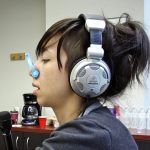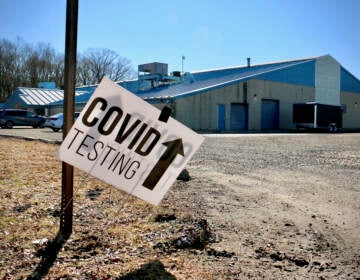Untested stimulants surface in pre-workout supplements
A Harvard researcher is sending up red flags about a popular class of supplements, some of which contain amphetamine-like drugs.
Listen 8:01
Kevin Kreider, a model and former bodybuilder, lifts weights at his local gym. Kreider says he quit pre-workout after becoming addicted. (Liz Tung/WHYY)
These days, Kevin Kreider fuels his workouts with little more than a cup of black coffee. But for about seven years, he relied on something else: a kind of supplement called pre-workout.
“This stuff was just like crack to me,” he says. “It was like amazing. That was the first time that I felt like something similar to ephedra.”
He’s a model and fitness life coach — plus a former bodybuilder.
Kreider first tried pre-workout in 2006. It was two years after the U.S. Food and Drug Administration (FDA) had banned ephedrine, an herb-derived weight-loss stimulant, for its health risks. For bodybuilders like Kreider, pre-workout seemed like the perfect alternative.
“What I heard about pre-workouts, what they would do specifically, is give me the heightened energy that it would make me work past my normal threshold of pain,” he says. “You’re going to have that laser-like focus, you’re going to lift more, you’re going to get big, you’re going to also lose fat and shred at the same time. And there were just like all these promises that sounded awesome.”
Pre-workout is available either as a supplement or a flavored drink powder. There are countless varieties, but most contain the same basic ingredients: amino acids to boost muscle function and recovery, and caffeine for energy. Kreider noticed the extra energy right away.
“I remember taking my first serving, and I was just so hyper and energized,” he says, of his first weightlifting session on pre-workout. “I loved it.”
Hours later, the effects were still going.
“Literally, I remember in my bed, it was like 2 a.m. and I was like, I can’t go to sleep,” he says. “My mind was going at a thousand thoughts per minute, but it did feel euphoric. It felt like I was high.”
The effects worried Kreider — but he also found them intoxicating. He started taking pre-workout regularly, even on days he wasn’t going to the gym. And slowly, his intake increased.
“You’re supposed to only have like one to three scoops,” Kreider says. “I’d be like, OK, I’m going to have three and a half. OK — four.”
Stimulants in supplements
As it turned out, the pre-workout former bodybuilder Kevin Kreider was taking had something more than just amino acids and caffeine. It included dimethylamylamine, or DMAA, an amphetamine-like stimulant that the FDA began cracking down on in 2012.
The crackdown came after the well-publicized deaths of two soldiers in 2011. The soldiers had taken a pre-workout called Jack3d, and that incident led to increased federal scrutiny of workout supplements. It was never proven that Jack3d caused the fatalities, but the manufacturing company eventually agreed to reformulate the product.
When The Pulse asked for input on this story, the company, USPlabs, didn’t respond to multiple requests for comment.
Despite the FDA’s stepped up surveillance, pre-workouts that purport to contain DMAA are still available online.
Pieter Cohen, an internist and a professor at Harvard Medical School who’s gained a reputation as a “supplement detective,” has studied the products.
“I have lost track of how many supplements we have found to contain these types of drug-like compounds,” Cohen says. “It’s countless, countless.”
Cohen says the closest estimate may come from the U.S. Anti-Doping Agency’s list of “High-Risk Supplements.” (Log-in needed to view.)
“Anti-doping experts [are] telling me that there’s over a thousand different supplements on their list at present,” Cohen says. “And that list is not comprehensive.”
The list runs the gamut from steroids to hormone modulators. But one of the greatest concerns for Cohen and regulators are stimulants like DMAA, which have been linked in anecdotal reports to stroke, heart attack and liver failure.
The FDA has listed half a dozen stimulants found in pre-workout supplements that are of concern. Cohen has identified some of those substances, which he calls “novel stimulants,” himself.
“These novel stimulants are particularly worrisome because they’ve often never been through accurate testing in humans,” he says. “So it might be that something has a serious side effect, but we would have absolutely no idea.”
The FDA
Cohen has been a vocal critic of the FDA for its failure to warn consumers about some of these substances and the supplements that contain them. But he admits there’s a larger problem.
“Fundamentally, the problem is not the lack of FDA enforcement,” Cohen says. “Fundamentally, it’s the law.”
Thanks to the Dietary Supplement Health and Education Act of 1994, the FDA no longer has the power to regulate supplements in the same way it regulates drugs.
Josh Sharfstein is a public health professor at Johns Hopkins University who previously served as Principal Deputy Commissioner at the FDA.
“It’s always a question of, does the agency need a better law? Or does the agency just need to do a better job with the law?” Sharfstein says. “I think on dietary supplements, it’s 90/10. The agency needs a better law, 90 percent; 10 percent, the agency can do better. And the reason is the law really pushes the agency to have to do a huge amount of work before they can spot problems in the market. And that puts everyone at risk.”
Sharfstein says the law requires the FDA to prove that a supplement is unsafe before the agency is able to take action. That requires lab tests, which are expensive and time-consuming. Even when the agency does succeed in banning a substance, enforcement can be difficult.
“There’s research that even after ingredients are banned, they’re still found in dietary supplements,” Sharfstein says. “Then you have a separate problem that the companies could try to alter the substance of try[ing] a different ingredient.”
For instance, a company selling a pre-workout containing a banned stimulant might simply replace it with a similar substance that functions in a similar way but is technically a different chemical.
Solutions
Both Cohen and Sharfstein agree that, thanks to internet sales, the problem seems to be growing.
“I think it’s definitely getting worse,” Sharfstein says. “Because it’s just so much easier for people to sell dietary supplements and the market for some of these ingredients has grown quite a lot.”
Cohen doubts that things will change anytime soon, but says he’s optimistic that one day, the law will change.
“At some point, I think that we’re going to decide that we don’t want to take pills and powders that are advertised as if they improve our health when they actually have no evidence that they work and might be putting our health at risk,” he says.
There does seem to be growing consciousness of the possible danger.
For instance, model and fitness coach Kevin Kreider quit using pre-workout about a year and a half ago, and he’s been outspoken about the reasons why.
“It definitely worked — it gave you that promise,” he says.
But he adds that, for him, the gains weren’t worth the cost.
“You know, like they say, everything in moderation. But the problem is, it just feels so good that you don’t do it in moderation.”
WHYY is your source for fact-based, in-depth journalism and information. As a nonprofit organization, we rely on financial support from readers like you. Please give today.







